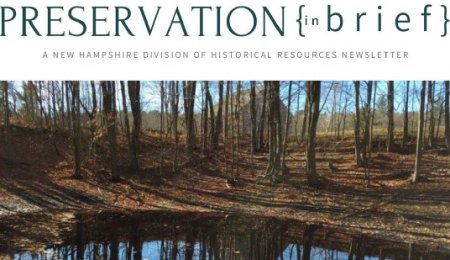DHR Celebrates 50th Anniversary
Transcript of video:
In his letter to the governor on the eve of the first anniversary of the creation of New Hampshire’s State Historic Preservation Office, George Gilman, Commissioner of the Department of Resources and Economic Development wrote the following: “As you know, historic preservation is not merely a concern for the past, but a positive program for the future which can, and already does, provide jobs, housing and recreation for the people of New Hampshire. Increasingly, preservation is being recognized as an important economic force which conserves tax base as well as cultural resources. … Clearly, a strong historic preservation program is also a sound economic program.” For fifty years the Division of Historical Resources has continued to embody these principles through its programs and services.
Whether it’s been called preservation or not, people in New Hampshire have worked to connect historic places with the past and with each other over the course of time. First, through the publication of books, poems, and articles like Jeremy Belknap’s 1792 three-volume The History of New Hampshire, which afforded the first comprehensive overview of the state’s past, to the publication of Warren Moorhead’s systematic survey of archaeological resources along the Merrimack River in 1939, to the more recent 2001 A Building History of Northern New England by James Garvin, which allows for the understanding of architectural styles and building evolution. The breadth of New Hampshire history is well documented.
As important as the written record is to understanding our past, so are experiences in places of history. As early as 1845, the Benning Wentworth Mansion in Portsmouth was opened to visitors for its historic importance with the owners giving tours of the house, decorated with its original wallpapers and many of its furnishings from the 1750s and 1760s. The state was given title to the property in 1954, re-opened the house to visitors in 1958 and continues to do so to this day. [Wentworth Mansion photos]
Until the late 1950s, preservation in New Hampshire had been largely limited to single structures recognized as homes of interesting or historically significant individuals, or notable for their architecture. With the creation of the State Historical Commission in 1955 and the state historical marker program that same year, the New Hampshire legislature began taking steps to preserve the state’s heritage and to improve the public’s understanding of such heritage.
Development pressures including the buying, clearing and preparation of land for urban renewal became a leading concern in many New Hampshire communities in the late 1950s and into the 1970s heralding in a new day for the protection of our historic resources. Strawbery Banke, Inc., which took over ten acres and twenty-seven buildings in the “Puddle Dock” area of Portsmouth eventually opened some of the houses to the public in 1965. Standing in the oldest part of the city, it was the first instance in the nation in which historic preservation was accepted as the principal development goal in an urban renewal project.
The loss of important historic places on a national scale became the impetus for the federal government’s creation of the National Historic Preservation Act of 1966, which among other things established the National Register of Historic Places, enacted a program of federal historic preservation matching grants, and authorized the creation of a State Historic Preservation Office in each state. It was on October 15, 1966, the day the Act was signed by President Lyndon B. Johnson, that the first four New Hampshire properties were entered into the National Register of Historic Places: Saint Gaudens in Cornish, the MacDowell Colony in Peterborough, the MacPhaedris-Warner House in Portsmouth and the Franklin Pierce Homestead in Hillsborough.
New Hampshire was slow to officially establish a State Historic Preservation Office and eventually after several false starts enacted its state preservation program within the Department of Resources and Economic Development on July 1, 1974, with Mary Jeglum as its director. Jeglum, taking her role and federal mandate seriously, challenged the preemptive demolition of historic buildings within an urban renewal area in Claremont and she encouraged the preparation of a National Register nomination for the Isles of Shoals, knowing that a determination of eligibility for the Shoals would require federal review of a proposal to build an oil tanker offloading depot and underwater pipeline at the islands as a component of a refinery planned by shipping magnate Aristotle Onassis. Jeglum was dismissed from her position at the end of 1974, and the entire office was suspended until Linda Ray Wilson came on board as director in early 1975. Linda would stay with the State Historic Preservation Office for the remainder of her career, until 2011. Her contribution to the protection of the state’s important and special places is unmatched.
Linda was joined by archaeologist Dr. Gary Hume in 1976. It was in 1982 that Hume, who earned the title of State Archaeologist in 1984, initiated an avocational archaeological program through which anyone interested in archaeology could participate in training and receive certification in various categories of field research, education, conservation, and interpretation. The robust State Conservation and Rescue Archaeology Program, known by its acronym, SCRAP, most recently boasted 60 volunteers contributing approximately 3000 hours of donated time to the study of sites that are not protected by government regulations, but are threatened by erosion, vandalism, and unregulated development.
In the early years of the state preservation office, there was a flurry of activity to identify and recognize key landmarks around the state, and by 1980 a backlog of nearly sixty National Register nominations had been submitted requiring processing by the small, but dedicated staff, which in 1977 expanded to include architectural historian, Christine Fonda Rankie. Today, the number of National Register listings is over nine hundred. In the early days there was money from the state preservation office through the historic preservation fund for them to subgrant money to pay for surveys and rehabilitation at fifty significant historic properties. This is how the historic landscape of Canterbury Shaker Village was mapped, and archaeological excavations at the Temple Glassworks site, Strawbery Banke, and an underwater survey of the Picscataqua estuary were undertaken.
In 1986, then Governor John Sununu reorganized state government and placed the preservation office in a new Department of Cultural Affairs along with the State Library and other agencies with allied missions. With increased funding, the New Hampshire State Historic Preservation Office was named the Division of Historical Resources, often shortened to DHR. As a fully developed and comprehensive preservation program, the DHR’s responsibilities outside of environmental review and survey grew with the expansion of federal and state legislation. The 1976 expansion of the National Historic Preservation Act of 1966 established the Federal Historic Preservation Tax Incentives Program. It requires DHR staff guide important redevelopment projects that have since resulted in more than $500 million dollars in the reinvestment in some of New Hampshire’s most iconic historic properties. Later, in the early 1980s, state enabling legislation allowed towns to establish local historic district commissions and the Certified Local Government Program spurred important federal, state and community partnerships supporting preservation at the local level. Today, the program has 29 participant communities. Since the program’s inception, more than $1.5 million dollars in subgrant awards have been awarded to CLG communities, mostly for planning and educational outreach projects.
The DHR couldn’t do the important work it does without collaboration with other statewide entities and partners. Some, like the New Hampshire Archaeological Society, founded in 1947 to share information and to stimulate scientific research of New Hampshire’s past existed well before the DHR and carried out important work that wouldn’t have otherwise been accomplished. The New Hampshire Historical Society played an important role in providing staff and library resources that were crucial to the survival of the state preservation program for a decade, from 1976 to 1986. And the organization of Inherit New Hampshire in 1985, a new statewide nonprofit historic preservation advocacy organization later renamed the New Hampshire Preservation Alliance, reinforced that the state’s historic preservation mission relies on many partners, working collaboratively, to preserve, revitalize and protect historic structures throughout the state.
The DHR has established and continues to expand working relationships with statewide organizations and agencies involved with history and heritage at all levels. Probably one of the earliest robust partnerships with state agencies is with the Department of Transportation that strengthened throughout the 1990s. The collaborative spirit of joint review of transportation projects through monthly cultural resources meetings between DHR, DOT and federal agencies is unique in the nation and has improved communication and successful project outcomes. This approach has extended to other agencies.
The early 2000s marked another pivotal era in New Hampshire’s preservation story with the creation of three synergistic programs: the New Hampshire State Register of Historic Places, the Conservation License Plate Program, affectionately called the Moose Plate Program, and the Land and Community Heritage Investment Program, most often called LCHIP. The New Hampshire State Register offers broader flexibility and inclusiveness with its criteria for listing than the National Register of Historic Places and recognizes meaningful community landmarks. Inclusion in the State Register is often a key component to qualifying for grant funding for both coveted Moose Plate and LCHIP grants. Since its inception, the State Register boasts nearly 500 listings and is growing. The idea of the Conservation License Plate Program started with fourth grade students at the Holderness Central School in 1993 and was created by the legislature in 1998 as a program to supplement existing state conservation and cultural heritage funding. The DHR’s grant program began in 2003 and in its twenty plus years has granted over $2 million dollars to New Hampshire communities for the rehabilitation of their special places. DHR works in support of LCHIP and their grant program, which has helped rehabilitate 170 historic structures statewide, by serving on the organization’s grant panel and assisting with the technical review of funded projects.
In the past few years and in the coming years, the DHR is adapting and embracing technological advances in the profession. The launch of the Enhanced Mapping and Management Information Tool, most often referred to as EMMIT, was the first step in providing a comprehensive digital archive and access to the DHR’s fifty years of archaeological and architectural inventory, which includes more than 16,000 records. Upgrades are in progress for EMMIT to include an online submission platform for review and compliance projects as well as survey and inventory. This is paving the way for historic preservation to be incorporated into everyday decision-making by everyone at every level.
These words from an early planning document for the state preservation office and its collective preservation policy states: “Preservation serves a deep social need for all of us. … This becomes a search for sanity in existence and that is reason enough to strive for understanding of the past and its proper utilization to confront the future.” These words continue to frame the work the grass-roots efforts and community spirit New Hampshire’s preservation partners will carry into the next fifty years.






